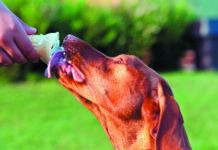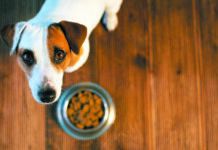For the most part, there’s no scientific proof that breed-specific diets are better for the health of a particular breed of dog than a food marketed for dogs in general. Granted, “not all of these diets are just marketing,” says Tufts veterinary nutritionist Cailin Heinze, VMD. “There is some science behind some of the formulations.” The companies just don’t have the proof that those formulations actually translate to a dog’s better health.
In one particular area, however, some breed-specific foods do have actual clinical investigation behind them: the shape and size of the kibble, which could conceivably have an impact on a dog’s health. “Royal Canin, as an example, has done a lot of studies looking at how dogs (and cats) of various breeds pick up their food,” Dr. Heinze explains. “They feed pets of different breeds on glass panels with cameras underneath” to capture their eating. That, in turn, allows them to shape the kibble in such a way that is better for the animal to pick up and chew.
For instance, in the case of Royal Canin’s food for bulldogs, the company’s kibble is wave-shaped, “like a big squiggle,” Dr. Heinze says. “That’s because based on their research, that makes it easier for a bulldog’s flat face to pick up.” (Their Persian cat kibble is shaped like a football for the same reason.)
The company’s kibble for Labrador retrievers, by contrast, “is huge and has a hole in the middle.” In internal (unpublished) studies, the company measured the time it takes Labs to eat differently shaped kibble and found that it takes twice as long to eat food configured that way. “Admittedly,” Dr. Heinze says, “we’re talking maybe the difference between 30 seconds and a minute or two. But that could be the difference between a dog’s feeling comfortable and less likely to bloat versus getting burpy and full of gas. Certainly, slowing down food consumption is never a bad thing with a dog like a Lab that tends to eat too fast, even though it needs to be pointed out that we’ve been feeding Labs regular round kibble for years without widespread problems.”
Strictly speaking, for the studies leading to the food shapes to be considered “the gold standard,” they would have to have been published in peer-reviewed journals, where veterinarians or scientists familiar with the subject matter look over the research parameters and the data to make sure they’re of high quality. But “that kind of data would probably never be peer reviewed,” Dr. Heinze points out, “first because the companies don’t want to give their expensively obtained data to competitors who may not be spending any money on research, and also because it’s not exactly the kind of research that is going to be really exciting to typical veterinarians or other scientists. You’re unlikely to see research on kibble shape in veterinary journals unless it made a dramatic difference in some health problem, although it might show up in a food science journal.”




